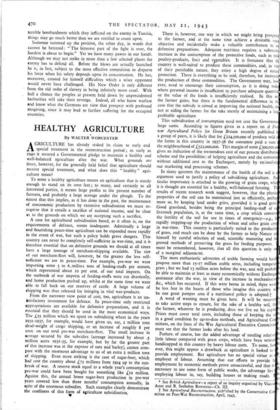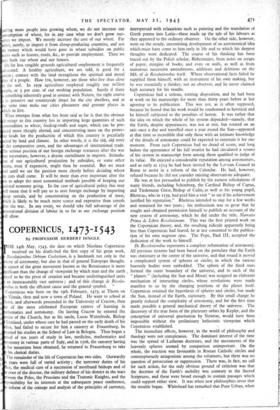HEALTHY AGRICULTURE
By WALTER WORCESTER
AGRICULTURE has already staked its claim to early and
special treatment in the reconstruction period ; as early as x94o it secured a Governmental pledge to maintain a healthy and well-balanced agriculture after the war. What grounds are there, however, for the generally held belief that agriculture should receive special treatment, and what does this " healthy " agri- culture mean?
To some a healthy agriculture means an agriculture that is sturdy enough to stand on its own feet ; to many, and certainly to all interested parties, it means large profits to the present number of farmers, and probably a large acreage under the plough. To the extent that this implies, as it has done in the past, the maintenance of uneconomic production by extensive subsidisation we must re- cognise that it entails a sacrifice of national income, and be clear as to the grounds on which we are accepting such a sacrifice.
A case for agricultural subsidisation based, as it often is, on the
requirements of defence, seems inadequate. Admittedly a large and flourishing peace-time agriculture can be expanded more rapidly in the event of war, but such a policy holds grave dangers. This country can never be completely self-sufficient in war-time, and it is therefore essential that on defensive grounds we should at all times have a large tonnage of merchant-shipping available. The size of our merchant-fleet will, however, be the greater the less self- sufficient we are in peace-time. For example, pre-war we were importing some 5 to 6,million tons of feeding-stuffs per annum, which represented about to per cent. of our total imports. On the outbreak of war imports of feeding-stuffs were cut drastically, and home production pushed up, whilst at the same time we were able to fall back on our reserves of cattle. A large volume of shipping was thus released for bringing in vital war-products.
From the narrower view point of cost, too, agriculture is an un-
iatisfactory investment for defence. In peace-time only restricted appropriations are available for defensive preparations, and it is essential that they should be used in the most economical ways. The £25 million which we spent on subsidising wheat in the years 1931-1937, for example, would have given us, say, 2 million tons dead-weight of cargo shipping, or an increase of roughly 8 per cent. on our total pre-war merchant-fleet. The small increase in acreage secured by the subsidies (acreage increased by about .5 million acres 1931-35, for example, but by far the greater part of this increase was at the expense of oats andbarley), cannot com- pare with the enormous advantage to us of an extra 2 million tons of shipping. Even more striking is the case of sugar-beet, which had cost the country about £75 millions from 1924 up to the out- break of war. A reserve stock equal to a whole year's consumption pre-war could have been bought for something like £to million. Against this, the annual home sugar-beet production in pre-war years covered less than three months' consumption annually, in spite of the enormous subsidies. Such examples clearly demonstrate the costliness of this form of agriculture subsidisation. There is, however, one way in which we might bring prosperi to the farmer, and at the same time achieve a desirable s objective and incidentally make a valuable contribution to defensive preparations. Adequate nutrition requires a substan increase in the consumption of the protective foods, such as poultry-products, fruit and vigetables. It is fortunate that country is well-suited to produce these commodities, and, in vi of their perishable nature, they enjoy a high degree of natu protection. There is everything to be said, therefore, for increas the production of these commodities. The Government may, ho ever, need to encourage their consumption, as it is doing toda where personal income is insufficient to purchase adequate quantiti or the value of the foods is insufficiently realised. In this w the farmer gains, but there is the fundamental difference in th case that the subsidy is aimed at improving the national health, not at aiding the farmer for the sake merely of maintaining a lar profitable agriculture.
This subsidisation of consumption need not cost the Governme large sums. According to figures given in a report on 4 Po war Agricultural Policy for Great Britain recently published a group of peers, it is likely that for £224,5oo,000 of produce sold the farms in this country in 1937-38 the consumer paid a sum the neighbourhood of £522,00o,00o. This margin of some £3oo,000. gives an indication of the tremendous cost of our present distribut scheme and the possibilitie3 of helping agrictilture and the consum without additional cost to the Exchequer, merely by rat:onalist our marketing and processing schemes.
In Many quarters the maintenance of the health of the soil is argument used to justify a policy of subsidising agriculture. titular importance is attached to the growing of grain crops, wh it is thought are essential for a healthy, well-balanced fanning. results of recent research work suggest, however, that the physi properties of the soil can be maintained just as efficiently, perha more so, by keeping land under grass, provided it is good gras Good grassland, besides being the principal feeding-stuff of o livestock population, is, at the same time, a crop which consen the fertility of the soil for use in times of emergency—e.g., f rapidly stepping-up the production of wheat and other grain c in war-time. This country is particularly suited to the producti of grass, and much can be done by the farmer to help Nature a himself by careful selection of seed, scientific manuring and i proved methods of preserving the grass for feeding purposes. must be remembered, however, that all this question is only of a marginal adjustment.
The most enthusiastic advocates of arable farming would hat propose more than 15-17 million arable areas, including tempo grass ; but we had 13 million acres before the war, and will proba be able to maintain at least as many economically without Excheq assistance after the war, in view of the increase in mechanism' &c., which has occurred. If this were borne in mind, there wo be less fear in the hearts of those who imagine this country be one great pampas area if a nutritional policy is adopted:I- A word of warning must be given here. It will be necess to take active steps to ensure, for the sake of a healthy soil, the farmer, whatever he is producing, does not live on his cap!! Prices must cover total costs, including those of keeping the s in a good condition by up-to-date methods, and Agricultural C minces, on the lines of the War Agricultural Eicecutive Commit! must see that the farmer looks after his land.
Pasture, of course, has the added advantage of needing relativ little labour compared with grain crops, which have been seriou handicapped in this country by heavy labour costs. To some, h ever, this might appear a drawback as agriculture is looked to provide employment. But agriculture has no special virtue as employer of labour. Assuming that our efforts to provide employment by economic methods prove unsuccessful, and that it necessary to use some form of public works, the advantage lies employing labour in, say, building houses or making roads.
* See British Agriculture—a report of an inquiry organised by Visco Astor and B. Seebohm Rowntree—Ch. III.
t See Agricultural Reconstruction, published by the Conservative mince on Post-War Reconstruction, April, 1943. putting more people into growing wheat, we do not increase our nsumption of wheat, for in any case what we don't grow our- hues we import. We merely increase the cost of our wheat. Far etter, surely, to import it from Cheap-producing countries, and use he money which would have gone in wheat subsidies on public arks such as houses, roads, &c., to provide employment. Then we 3%e both our wheat and our houses.
On far less tangible grounds agricultural employment is frequently ,ivocated. A healthy agriculture, we are told, is good for a anon ; contact with the land strengthens the spiritual and moral ',,re of a people. How few, however, are those who live thus close
o the soil. In 1939 agriculture employed roughly one million eople, or 5 per cent. of our working population. Surely if there s something inherently good in contact with Nature, the right course s to preserve our countryside intact for the city dwellers, and at e same time make our cities pleasanter and greener places in hich to live.
What emerges from what has been said so far is that the obvious vantage to this country lies in importing large quantities of such ommodities as wheat, feeding-stuffs and sugar, which can be pro- uced more cheaply abroad, and concentrating more on the protec-
• ve foods for the production of which this country is .peculiarly uited by land and climate. In other words, it is the old, old story f the comparative costs, and the advantages of international trade. he serious position of our foreign exchange resources after the war ay necessitate, however, a drastic curtailment in imports. Stimula- ion of our agricultural production by subsidies, or some other eans, even if expensive, might then be essential. But we must ait until we see the position more clearly before deciding where e cuts shall come. It will be more than ever important after the ar to adopt the most economical methods possible of keeping our ational economy going. In the case of agricultural policy this may ell mean that it will pay us to save foreign exchange by importing heap cereals, and by concentrating on the production of meat, hich is likely to be much mere scarce and expensive than cereals fter the war. In any event., we should take full advantage of the ternational division of labour in so far as our exchange position ill allow.



























 Previous page
Previous page